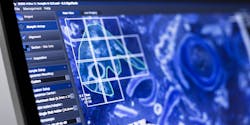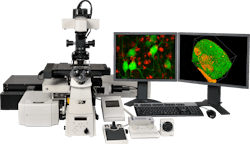Neuro15 exhibitors meet exacting demands: Part 2

(Editor's note: Read "Neuro15 exhibitors meet exacting demands: Part 1" here.)
Increasingly, neuroscientists are working with researchers in disciplines such as chemistry and physics. This trend has been noticed by exhibitors at the Society for Neuroscience (SfN) annual meeting (October 17-21, 2015; Chicago, IL), and was in evidence throughout the conference program. Perhaps such collaboration is why the field of neuroscience seems better able to appreciate the capabilities of technology. For sure, exhibitors at Neuroscience dished up plenty to entice them.
Microscopy and more
Multiphoton and other microscopy approaches were a major theme at Neuroscience. And at least a couple of companies offered solutions for turning tissue transparent: LogosBio’s exhibit focused on X-Clarity, a product based on Stanford-licensed technology that promises to clear an entire mouse brain in just six hours. Zeiss, too, discussed advancements in rapid imaging of large cleared samples—as well as use of its Airyscan technology for deep multiphoton imaging, and the “digital classroom,” which lets teachers use an iPad and imaging app (Labscope) to turn one or more microscopes/cameras into a WiFi-enabled system that can display live images from all connected instruments. The company also demonstrated Atlas 5, which extends Zeiss scanning electron microscopes (SEMs) and focused ion beam SEMs to navigate and correlate images from any sources including light and x-ray microscopes (see photo below).Probably the biggest attention-getter in the Zeiss booth, though, was a station that used virtual reality technology to let visitors “fly through” neurons. That demo was based on work that garnered a 2014 Microsoft Life Sciences Innovation Award: Zeiss, software developer arivis AG, and the Harvard Center for Biological Imaging (HCBI) won for a platform to rapidly image, manage, and share unlimited-sized datasets to standard desktops and laptops, for 3D visualization and analysis.
Nikon Instruments, too, demonstrated multiphoton and super-resolution systems, including its new Dual IR A1r+ Multiphoton, which enables simultaneous two-color imaging (see photo below); and N-STORM 4.0 for imaging live, dynamic events at 10X the resolution of conventional light microscopes. Nikon also offered tools for optogenetics applications including digital micro-mirror devices and laser-point-scanning devices to turn on neurons.
Olympus announced its new SD-OSR microscope featuring both confocal and super-resolution modes: The system combines 120 nm resolution, >50 µm cell depth penetration, and three frames/s imaging speed, and promises to overcome the poor contrast of many super-resolution systems. The company also discussed its new Olympus Scientific Solutions Americas R&D group, its new R&D program dedicated to helping meet the needs of North American researchers whose advanced microscopy and imaging needs require customized technology.Bruker showed neuroscientists its advanced preclinical imaging and fluorescence microscopy solutions for neurology, functional and anatomical neuroimaging, in vivo imaging of the nervous system, optogenetics, in vitro imaging of brain slices in conjunction with electrophysiology, and more. Thanks to recent acquisitions, the company’s range of techniques includes two-photon, confocal, and super-resolution microscopes, as well as optical and MALDI imaging. Its flagship Ultima IntraVital multiphoton system is designed for high-speed live animal imaging, and includes optogenetics modules. With the aid of a gradient refractive index microendoscope (GRIN lens), its multiphoton microscopy approach allows imaging of deeper structures in the brain.
Navitar promoted apochromatic objectives customized with high numerical apertures and long working distances (0.3–30 mm) optimized for two-photon microscopy that can be tailored for aqueous, oil, and vacuum research environments.
And more
Optical coherence tomography (OCT) is not yet well established in neuroscience, but Wasatch Photonics was one of two companies (Thorlabs being the other) to introduce it to Neuroscience attendees. Wasatch says its expertise in high-throughput VPHG spectrometers provides 20x more signal than competing models.
Lumencor, maker of bright, energy-efficient lighting products, notes that its light engines are being widely used by neuroscientists for photostimulation of optogenetic transducers.
Similarly, Market Tech showed the Omicron LedHUB, a high-power LED light source with its up to 6 different wavelengths between 365 and 840 nm for optogenetics among other applications.
Finger Lakes Instrumentation (FLI) demoed its high speed filter wheels that promise “the fastest filter exchange on the market.” Its new High Speed Rotator, based on a custom design done for Janelia Farm, allows 5 ms switching and digital triggering—and demonstrates the company’s prowess in custom creations.
Demanding work in neuroscience often requires absolute stability. To this end, Newport previewed its Guardian AIW-series Active Isolation Workstations, promising unmatched vibration isolation from 0.5 Hz and 6 DOF for researchers using super-resolution microscopy. And TMC Ametek used the event to launch its new compact, benchtop active vibration cancellation system, Everstill K-400, which features geophone-type velocity sensors for sub-hertz sensitivity.
Optical technology is also involved in exciting developments such as PCR quantification, offered, for instance, by Bio-Rad’s high-throughput, ultra-sensitive Droplet Digital PCR System.
About the Author

Barbara Gefvert
Editor-in-Chief, BioOptics World (2008-2020)
Barbara G. Gefvert has been a science and technology editor and writer since 1987, and served as editor in chief on multiple publications, including Sensors magazine for nearly a decade.

